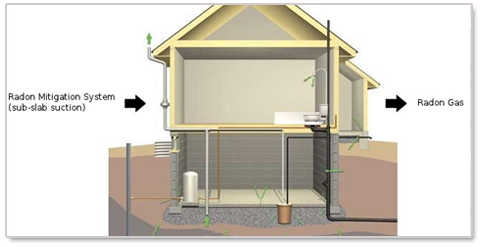Radon Abatement in Iowa
Radon abatement is a service that we offer to reduce the radon levels in your Iowa home. If you are concerned that your home has elevated levels of radon gas, you should have your home tested for radon. Ameriserv offers short term tests to get a general idea of the radon levels in your home, and long term tests to give you a more accurate estimate of the dangers you are dealing with. Radon can be harmful to the health of you and your family – do not hesitate to invest in radon abatement services as soon as you discover a radon problem in your home.
Radon abatement can be accomplished in a couple of different ways: either by installing a ventilation system that allows radon gas to exit the home through a suction point on the concrete floor slab, or by upping the frequency of air changes per hour in the building. At Ameriserv, we normally opt to install a ventilation system to ensure that the radon is removed from your home. This system is installed by:
 Drilling a hole in the foundation or slab to create a suction point for the system.
Drilling a hole in the foundation or slab to create a suction point for the system.- Installing PVC pipes to form a vent for the radon to travel through.
- Connecting PVC pipe ventilation system to suction point.
- Putting in a fan to ensure that air flow travels in the proper direction (fan is normally installed in attic)
This system runs continuously to keep radon levels in your home low. Any question about the installation of this system can be answered by the professionals here at Ameriserv Radon Mitigation. For radon abatement Iowa services, call us now.
Importance of Radon Abatement for Iowa Homes
Iowa homes are known to have dangerously high levels of radon – each year, around 400 Iowans die due to radon exposure, and five out of every seven homes in Iowa have radon levels that are higher than the recommended safe level.
Because it is colorless, odorless, and tasteless, it is impossible to know whether your home has a radon problem or not without testing it. Invest in radon testing as soon as possible to keep your home safe. In addition to long term and short term radon tests, we also offer DIY testing kits.
Another way to reduce radon levels in your home is to check for any cracks, gaps, or spaces in the foundation and basement walls. Since radon comes from the soil, it often enters your home through cracks in the foundation and foundation walls. Sealing these cracks will lower the points of radon entry in your Iowa home. Contact us for more tips on lowering radon levels in your home.

